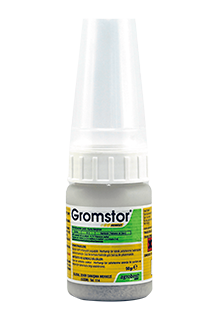
Gromstor
- Tribenuron-methyl

HERBICIDE GROUP B 2
PLANTS AND WEEDS ON WHICH THE PREPARATION IS USED
| Plant name | Weed name | Consumption rate |
| Wheat | Annual dicotyledonous weeds | 0.015-0.02 l/ha |
METHOD OF APPLICATION
GROMSTOR is a broad spectrum herbicide used to control broadleaf weeds on wheat. It is used in low doses. The selectivity is very high. It can be safely used from the time of wheat sowing until the heading period. Best results are achieved when the weeds are at least two-leaved, but up to 15 cm high or in diameter, and the weeds are not covered with grain. It should be applied in fields where blueberries are abundant, when blueberries have 7-8 leaves and a diameter of 8-9 cm.
Important: May damage trees and other crops if instructions for use are not followed. Avoid touching the roots of fruit trees or other cultivated plants with cultivated plants for which the use of the drug is not recommended during treatment. Do not pollute rivers and irrigation water.
General information:
GROMSTOR penetrates the organism of weeds through their roots or green parts. It has a small static effect underground. Efficient weed growth – stops shortly after application. Symptoms of the action of the drug appear 1-3 weeks after application, depending on the growth conditions of weeds, sensitivity to herbicides. A 2-hour rain-free period after treatment is important for weed control. After application, hot and humid conditions accelerate the action of CPP, while cold and dry conditions delay it.
Phytotoxicity:
GROMSTOR is not phytotoxic if the recommendations are followed. Do not apply GROMSTOR to plants that have been stressed by adverse weather conditions, drought, or damaged by pests.
Crop Rotation: After applying GROMSTOR on wheat and barley, you can plant any crop grown in a normal crop rotation.